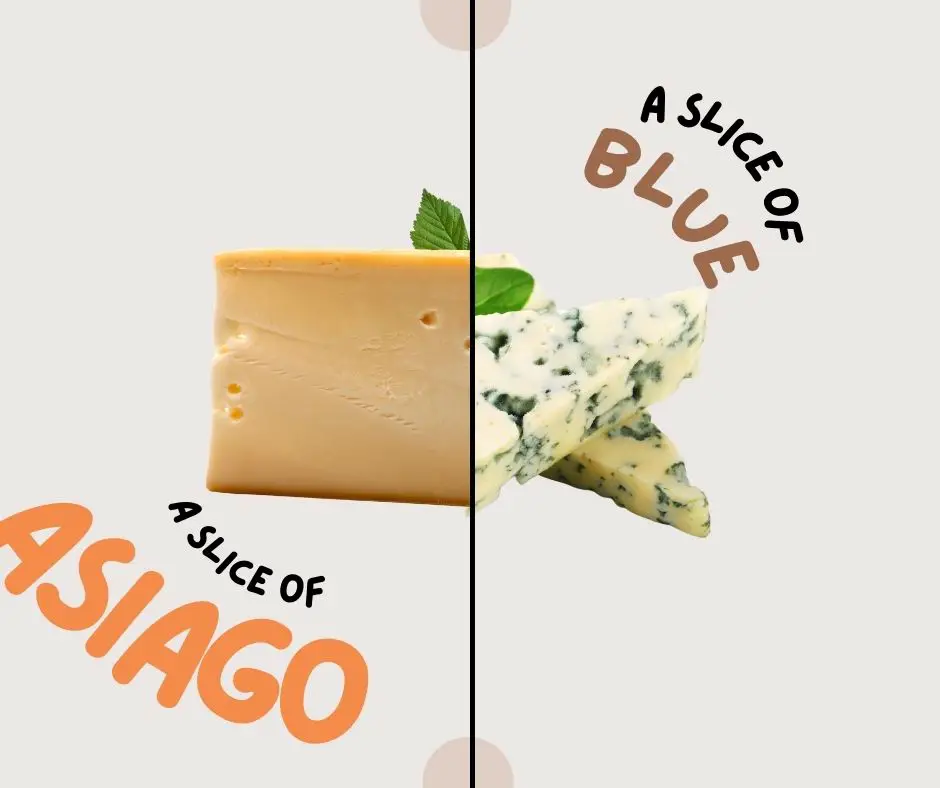Last Updated on March 23, 2024 by Aaron
Are asiago and blue cheese the same? No, they are not.
Asiago and blue cheese both share a lot in common; however, there are also some key differences that set them apart.
In this article, we’ll compare and contrast these two cheeses, so you can decide which one is right for you.
Table of Contents
Is Asiago like Blue Cheese?
Asiago and blue cheese are not the same. For one, Asiago is a cow’s milk cheese while blue cheese is a variety of cheese that is typically made from cow’s milk, sheep’s milk, or goat’s milk.
Some common types of blue cheese are Danish Blue, Stilton cheese, gorgonzola, Roquefort cheese, and danish bleu cheese.
In general, Blue cheese has a stronger, more pungent smell and flavor than Asiago.
How are they different?
Asiago cheese is a semi-hard Italian cow’s milk cheese that originated in Northern Italy. It is similar to Parmesan in both taste and texture (it should not be confused with parmesan). Asiago has a mellow, nutty flavor while blue cheese is tangy and salty.
Blue cheese gets its distinct blue-veined appearance from the mold Penicillium roqueforti (link) that grows on it during the aging process. Also unlike Asiago, blue cheese isn’t grated because it can be quite soft.
The color of Asiago cheese ranges from Ivory to pale yellow depending on the aging process. Blue cheese, on the other hand, usually has deep blue/green marbled veins and some varieties have an edible white rind – cambozola – sometimes known as blue brie.
Gorgonzola is typically aged for 2-4 months. While asiago aged for 2-4 months for Pressato, or up to 18 months for Asiago d’Allevo.
How do they use different?
Asiago is often used as a substitute for Parmesan – both are hard Italian cheeses that can be found in grated or block form. It is typically used as a table cheese or grated on pasta or risotto. It goes well with Italian cuisine like spaghetti carbonara.
On the other hand, blue cheese tends to go well with hearty dishes like steak, burgers, and roasted veggies. It is also popular for dressing salads and made into cheese dips.
Production
The production process for Asiago and blue cheese is also different. Both of these cheeses start with whole milk. Most of the gorgonzola production, even the DOP gorgonzola, goes through a pasteurization process (3) but Asiago productions are often unpasteurized, read how traditional asiago is made.
For asiago, the rennet and starter cultures are added to curdle milk. While gorgonzola uses rennet, enzymes, Penicillium Roquefort, and yeast.
After that, the curd mass is cut, drained, molded.
The asiago cheese curd is salted and hydraulically pressed for several hours, which is then proceeded to a cooling room at 10-15 C (50-59 F). For gorgonzola, the cheese curd is salted, and left in a warm room at 20-25 C (68-77 F).
Additionally for gorgonzola, the cheese will be punctured with metal spikes to allow oxygen to get inside the cheese.
For the last part, gorgonzola will be sent to a cooling room for maturation. Asiago will be soaked in a brine bath for several days, and sent to the maturation room.
Key Takeaway
The difference between Asiago and Blue Cheese is that the former is a cheese made from cow’s milk, while blue cheese can be made with cow, sheep, or goat milk.
The main difference in taste is that asiago has a mellow nutty flavor while blue cheese tends to have tangy salty flavors. Both cheeses go well on different dishes too.
Reference
- https://www.youtube.com/watch?v=KPqK5LyGsiE
- https://en.wikipedia.org/wiki/Gorgonzola
- http://www.bassiformaggi.it/en/dop-gorgonzola-s-production.html

